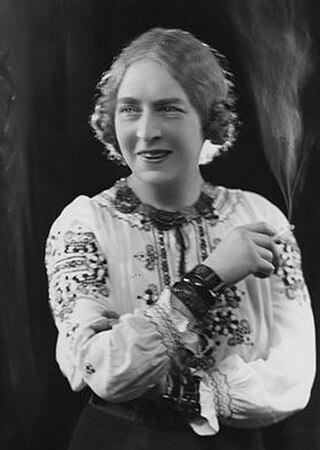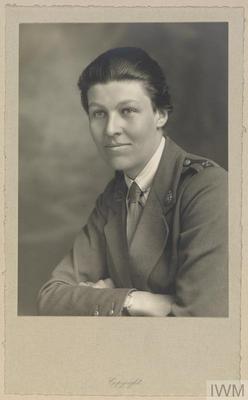
Elizabeth Southerden Thompson, later known as Lady Butler, was a British painter who specialised in painting scenes from British military campaigns and battles, including the Crimean War and the Napoleonic Wars. Her notable works include The Roll Call, The Defence of Rorke's Drift, and Scotland Forever!. She wrote about her military paintings in an autobiography published in 1922: "I never painted for the glory of war, but to portray its pathos and heroism."
She married British Army officer William Butler, becoming Lady Butler after he was knighted.

George Vernon Meredith Frampton was a British painter and etcher, successful as a portraitist in the 1920s–1940s. His artistic career was short and his output limited because his eyesight began to fail in the 1950s, but his work is on display at the National Portrait Gallery, Tate Gallery and Imperial War Museum.
Flora Marguerite Lion was an English portrait painter. Lion had a long and successful career and was known for her portraits of society figures, landscapes and murals.

Dame Laura Knight was an English artist who worked in oils, watercolours, etching, engraving and drypoint. Knight was a painter in the figurative, realist tradition, who embraced English Impressionism. In her long career, Knight was among the most successful and popular painters in Britain. Her success in the male-dominated British art establishment paved the way for greater status and recognition for female artists.

Anna Airy was an English oil painter, pastel artist and etcher. She was one of the first women officially commissioned as a war artist and was recognised as one of the leading women artists of her generation.

Lucy Elizabeth Kemp-Welch was a British artist and teacher who specialized in painting horses. Though increasingly overlooked after the Second World War, from the late 1890s to the mid-1920s she was one of the country's best-known female artists. As her obituary in The Times noted, 'Like most artists who came to maturity and were established before the end of the nineteenth century, Lucy Kemp-Welch suffered somewhat in her later reputation from the violent changes in art which followed. In her prime as an animal painter she held a position in this country comparable to that of Rosa Bonheur in France, and the only British woman artist of her generation who was more talked about was Lady Elizabeth Butler, painter of "The Roll Call".' Her reputation has since revived, and she is best known today for her large paintings of wild and working horses in the New Forest, and those in military service which she produced during the First World War, as well as for her illustrations to the 1915 edition of Anna Sewell's novel Black Beauty.
Evelyn Mary Dunbar was a British artist, illustrator and teacher. She is notable for recording women's contributions to World War II on the United Kingdom home front, particularly the work of the Women's Land Army. She was the only woman working for the War Artists' Advisory Committee on a full-time salaried basis. Dunbar had a deep devotion to nature and a particular affection for the landscape of Kent. Dunbar was modest regarding her achievements and outside of the post-war mainstream art world which has led to some neglect of her work until recent years. She painted murals at Brockley County Secondary School, and was a member of the Society of Mural Painters. After the war she painted portraits, allegorical pictures and especially landscapes. She attempted a return to mural painting in 1958 with a commission at Bletchley Park Teacher Training College, but was unable to fulfil the original specification.

Norah Neilson Gray was a Scottish artist of the Glasgow School. She first exhibited at the Royal Academy while still a student and then showed works regularly at the Paris Salon and with the Royal Academy of Scotland. She was a member of The Glasgow Girls whose paintings were exhibited in Kirkcudbright during July and August 2010.

Joanna Mary Boyce was a British painter associated with the Pre-Raphaelite Brotherhood. She is also known by her married name as Mrs. H.T. Wells, or as Joanna Mary Wells. She produced multiple works with historical themes, as well as portraits and sketches, and authored art criticism responding to her contemporaries. She was the sister of Pre-Raphaelite watercolourist George Price Boyce.
Stella Schmolle, was a British painter, known for the paintings she produced while serving in the Auxiliary Territorial Service during World War II and for her post-war portrait paintings.
Eleanor Hudson, known professionally as Erlund Hudson,, was a British artist. Hudson was a watercolourist, etcher and designer and is notable for her depictions of women at work during the Second World War and for her post-war paintings of ballet dancers.
Victorine Anne Foot was a British artist who worked in oils, watercolours and pastels. Foot is best known for her work during World War II on military camouflage and for her post-war career as an artist and teacher in Scotland.

Archibald Standish Hartrick was a Scottish painter known for the quality of his lithographic work. His works covered urban scenes, landscapes and figure painting and he was a founder member of the Senefelder Club.
Dorothy Josephine Coke was an English artist notable for her work as a war artist on the British home front during the Second World War. Coke was also an art teacher and as an artist was known for her watercolours, which have a very free, open-air quality to them.
Kathleen Guthrie was a British artist who exhibited with the London Group and at the Royal Academy and also had several solo exhibitions. During a long career Guthrie painted in oils and watercolours, produced silkscreens and murals and wrote and illustrated children's books.
Leila Elizabeth Josephine Worsley was a British artist, who throughout her career worked in a variety of media and who is best known for the artworks she produced during the Second World War, depicting events in Britain.
Victoria Monkhouse (1883–1970) was a British artist and illustrator, notable for her depictions of women working on the British Home Front during the First World War.
Ursula Ulalia Edgcumbe was a British sculptor and painter. As a sculptor she worked in stone, wood and bronze while, after switching to painting, many of her works depicted birds and groups of figures.

Beatrice Ethel Lithiby OBE was a British artist known as a painter and designer of stained glass and church furnishings. She served in both World War I and World War II in the British Army and in the former conflict also worked as a war artist for the Imperial War Museum.
Edith Mary Kemp-Welch (1870–1941) was a British artist, known as a portrait painter.










